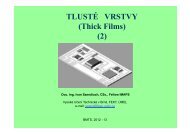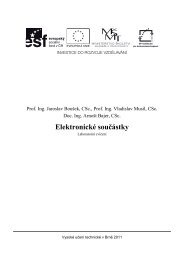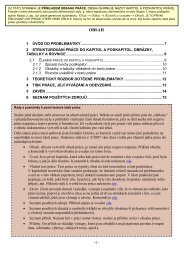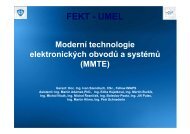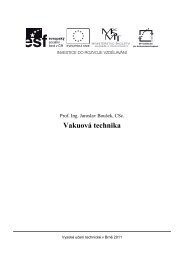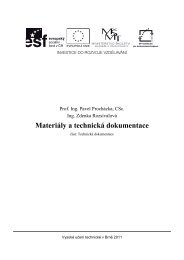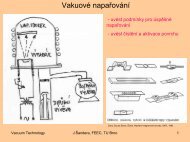ASIC Design Flow State-of-the-Art
ASIC Design Flow State-of-the-Art
ASIC Design Flow State-of-the-Art
- No tags were found...
You also want an ePaper? Increase the reach of your titles
YUMPU automatically turns print PDFs into web optimized ePapers that Google loves.
<strong>State</strong>-<strong>of</strong>-<strong>the</strong>-<strong>Art</strong><strong>ASIC</strong> <strong>Design</strong> <strong>Flow</strong>part 2David SmolaVladimír StrakošSCG Czech <strong>Design</strong> Center
Goals <strong>of</strong> this presentation:• to understand what “<strong>ASIC</strong>” means• to understand how an <strong>ASIC</strong> is developedidea… …chip realization… …chip applicationOUTLINE:Introduction<strong>ASIC</strong> design flow<strong>ASIC</strong> design exampleConclusion
OUTLINE: Introduction<strong>ASIC</strong> design flow<strong>ASIC</strong> design exampleConclusionIntroductionWhat is “<strong>ASIC</strong>”?Application Specific Integrated Circuit?
Introduction<strong>ASIC</strong> is actually an integrated circuit (IC),so let’s talk about it’s history a bit…Introduction - historyIBM 1996, 180 000transistors, few grams,70mm 2 , 200mWENIAC 1946, 17 500vacuum tubes, 27 tons,167m 2 , 150kW50years
Introduction – key milestonesThe first transistor: 1947John BardeenWalter BrattainWilliam ShockleyIntroduction – key milestonesIntegrated circuit invention:Ge<strong>of</strong>frey DummerIn1952camewithanideato fabricate multiple circuitsin one substrate.Jack KilbyIn February 1959 he appliedfor a patent for actually <strong>the</strong>first integrated circuit.Robert NoyceIn April 1961 he was awardeda patent for <strong>the</strong> first multitransistorintegrated circuit.
Introduction – key milestonesThe first IC: 1959One transistor and few passive components on ONE Germaniumsubstrate. The first usage was in military application.Ref: Texas InstrumentsIntroductionWhy are actually nowadays <strong>ASIC</strong>s widely used in highlyspecialized applications as well as in mass production?Let’s demonstrate <strong>the</strong> benefits <strong>of</strong> <strong>ASIC</strong>’s
Introduction – exampleExample: we want to implement a battery control system17V 12VBlackboxIntroduction – exampleMethod #1:Implement <strong>the</strong> function with passive componentsmanysupportingdevicescomparator
Introduction – exampleMethod #2:Implement <strong>the</strong> function with an <strong>ASIC</strong>fewsupportingdevices<strong>ASIC</strong>Introduction – exampleWhat method is more perspective for a customer in <strong>the</strong>following cases:10 FUNCTIONAL CIRCUITS10 000 000 FUNCTIONAL CIRCUITS? ? ? ? ? ? ? ?? ? ? ?
Introduction – exampleMethod #1: suppose we use one IC for 1$, 5 caps for 0.5$,LM317 for 1$ and PCB for 3$ total =7.5$ per 1PCB-10 FUNCTIONAL CIRCUITS: 75$-10 000 000 FUNCTIONAL CIRCUITS: 75Mil $Method #2: suppose <strong>the</strong> design work expenses are 1Mil $,1 set <strong>of</strong> masks for chip manufacturing 1Mil $, testinginstruments 1Mil $ total = 3Mil $ per 1 designed <strong>ASIC</strong>s-10 FUNCTIONAL CIRCUITS: 3Mil $-10 000 000 FUNCTIONAL CIRCUITS: 3Mil +/- 3Mil $General advantage <strong>of</strong> <strong>ASIC</strong>s: much cheaperfor a mass productionIntroduction – example<strong>ASIC</strong> circuits in highly specialized fields <strong>of</strong> engineering:In all <strong>the</strong>se fields <strong>the</strong>re is just “few”IC’s needed, but very advanced,robust and immune.
Introduction – advantagesAdvantages <strong>of</strong> <strong>ASIC</strong>s:• An <strong>ASIC</strong> solution gives better functionality and betterperformance than a corresponding discrete solution,especially for systems requiring low power consumption.• The weight and volume <strong>of</strong> <strong>the</strong> final product are <strong>of</strong>tenreduced significantly with <strong>ASIC</strong>s.• An <strong>ASIC</strong> solution means perfect product economy if <strong>the</strong>product is manufactured in a given minimum volume.• An <strong>ASIC</strong> provides excellent protection against copying <strong>of</strong>a product….Introduction – applicationsWhere do we use <strong>ASIC</strong>’s?In any field <strong>of</strong> nowadays human activity you can think <strong>of</strong>:• Any industry• Ecology• Aeronautics• Astronomy• Medical• Militaryetc…
OUTLINE:Introduction<strong>ASIC</strong> design flow<strong>ASIC</strong> design exampleConclusion<strong>ASIC</strong> design flow• When talking about <strong>ASIC</strong>s, we talk aboutdigital or mixed-mode integrated circuits• The following part will show steps that are followed duringdesign <strong>of</strong> an <strong>ASIC</strong> in AMIS: from initial contact with <strong>the</strong>customer to release <strong>of</strong> <strong>the</strong> product into production
<strong>ASIC</strong> design flowProductphasesoverview:PreStudy startProduct phases overview:Phase 0 – feasibility and quotingPhase 1 – PreStudyPhase 2 – developmentPhase 3 – Limited productionPreStudy endProject plan specified<strong>Design</strong> start<strong>Design</strong> Tape OutTesting prototypesCustomer prototype approvalLimited transfer to production<strong>ASIC</strong> design flow – Phase 0Phase 0 – feasibility and quotingCustomer expectations enter <strong>the</strong> appropriatebusiness unit through <strong>the</strong> Sales DepartmentThe goal:• to evaluate commercial interest <strong>of</strong> <strong>the</strong> project• to evaluate <strong>the</strong> technical feasibility, which• means technology capability, library availability,• test capability, CAD tool, human resources (all• by system architect)• to determine <strong>the</strong> need for ESD testing
<strong>ASIC</strong> design flow – Phase 1Phase 1 – PreStudyCustomer design requirements are analysed indetail. Preliminary design activity starts in orderto arrive at Project SpecificationsThe goal:• to construct a Project Plan• to start a hybrid design (behavioural modelling)• to identify <strong>the</strong> complete design team members• to sign <strong>the</strong> Project Specifications and Test• Plan by both customer and <strong>the</strong> <strong>ASIC</strong> developer<strong>ASIC</strong> design flow – Phase 1Quality level:• determined at <strong>the</strong> end <strong>of</strong> prestudyQuality level measures:• ppm400… consumer electronics, telecom(commercial), industrial, computer peripherals
<strong>ASIC</strong> design flow – Phase 2Phase 2 – DevelopmentThe Product Specifications must be signedbefore entering this phase. Practical designing<strong>of</strong> <strong>the</strong> <strong>ASIC</strong>The goal:• to execute design and layout tasks to fulfilparameters according to <strong>the</strong> Product Specifications• to manufacture <strong>the</strong> prototype and to test it• to receive customer’s prototype approval<strong>ASIC</strong> design flow – Phase 2Actual chip designTOP-DOWNTop-level schematic isconstructed beforeindividual cells aredesigned. Behaviouralmodels <strong>of</strong> cells are usedBOTTOM-UPThe individual cell aredesigned at <strong>the</strong> transistorlevel before or in parallelwith <strong>the</strong> construction <strong>of</strong>top-level schematic•Top-down design methodology is preferred whenever practical
<strong>ASIC</strong> design flow – Phase 2Top-down development sub-phases:• Chip level design• Cell / block design• Cell layout• Chip-level layout• Chip-level post-layout• Tech transfer• Fabrication and characterisation• Product reliability qualification• Transfer to productionChip level designCell/block designCell layoutChip-level layoutChip-level post-layoutTech transferFab,characterisationProduct reliability q.Limited transfer to pr.<strong>ASIC</strong> design flow – Phase 2Chip level designChip level designCell/block design12V 3V 1.2VREGBGrefBUSCell layoutChip-level layoutChip-level post-layoutsensor 1OAanalogMemory bankdigitalTech transferFab,characterisationrefOAADCCProduct reliability q.Limited transfer to pr.sensor 2OAOSCref• includes top-level floor-planning and top-level simulations
<strong>ASIC</strong> design flow – Phase 2Cell / block designanalogdigitalChip level designCell/block designCell layoutChip-level layoutChip-level post-layoutTech transferFab,characterisationProduct reliability q.Limited transfer to pr.OA• Manual circuit design• Schematic creationC• Logic syn<strong>the</strong>sis• Logic simulation• Automated / manualschematic creation• Schematic simulation• Schematic simulation<strong>ASIC</strong> design flow – Phase 2Manual analog cell / block designAnalog blockOpAmpCircuit topologyOA2-stage folded cascode OpAmpDevice parameters2-stage folded cascode OpAmpSystem-level kind <strong>of</strong>specifications:WL = 100.5- DC gain- unity gain frequency- supply voltage- maximal powerconsumption- noise specifications- THD specificationsAppropriate circuittopology selectionDevice sizingoptimisation, biasingcurrents setting,threshold voltagessettingSimulations(DC, TR, AC, Noise)iterativeprocessesCorner simulations(slow, fast, high/low temp)Verified schematic
<strong>ASIC</strong> design flow – Phase 2Cell / block layout – analog or digital• Manual or automatedlayout designChip level designCell/block designCell layoutChip-level layoutChip-level post-layout• Parasitic extractionTech transferFab,characterisationProduct reliability q.Limited transfer to pr.• schematic update,simulation withparasitic devices• LVS, DRC<strong>ASIC</strong> design flow – Phase 2LVS – Layout Versus Schematic• Device count and device sizes must equal
<strong>ASIC</strong> design flow – Phase 2DRC – <strong>Design</strong> Rule Check• layouted devices and metalor silicon tracks must musthave allowed dimensions,overlapping and spacing<strong>ASIC</strong> design flow – Phase 2Chip-level layout• Completion <strong>of</strong> <strong>the</strong> chip from cells/blocks into a top-level systemChip level designCell/block designCell layoutChip-level layoutChip-level post-layoutTech transferFab,characterisationProduct reliability q.Limited transfer to pr.• Parasitic extraction, update, simulation with parasitic devices• LVS, DRC
<strong>ASIC</strong> design flow – Phase 2Chip-level post-layout• Bonding diagram creationChip level designCell/block designCell layoutChip-level layoutChip-level post-layoutTech transferFab,characterisationProduct reliability q.Limited transfer to pr.• Where applicable, DRC<strong>ASIC</strong> design flow – Phase 2Tech transfer• Generating reticle informationChip level designCell/block designCell layoutChip-level layoutChip-level post-layoutTech transferFab,characterisation• Creating masks for lithographyProduct reliability q.Limited transfer to pr.
<strong>ASIC</strong> design flow – Phase 2FabricationChip level designCell/block designCell layoutChip-level layout• Wafer fabricationChip-level post-layoutTech transferFab,characterisation• PackagingProduct reliability q.Limited transfer to pr.<strong>ASIC</strong> design flow – Phase 2Testing, characterisation• Prototype evaluation and characterisationChip level designCell/block designCell layoutChip-level layoutChip-level post-layoutTech transferFab,characterisationProduct reliability q.Limited transfer to pr.
<strong>ASIC</strong> design flow – Phase 2Product reliability qualification• ESD and latch-up testingChip level designCell/block designCell layoutChip-level layoutChip-level post-layoutTech transferFab,characterisationOBR. ESD testingProduct reliability q.Limited transfer to pr.• Life-time testing(baking, freezing, moisturizing, pressurizing)<strong>ASIC</strong> design flow – Phase 2Limited transfer to production• Customer prototype approvalChip level designCell/block design• Direction into Phase 3 – prototype readyCell layoutChip-level layoutChip-level post-layoutTech transferFab,characterisationProduct reliability q.Limited transfer to pr.
OUTLINE:Introduction<strong>ASIC</strong> design flow<strong>ASIC</strong> design exampleConclusion<strong>ASIC</strong> design examples<strong>ASIC</strong> examples fullydeveloped at AMIS, Brno
<strong>ASIC</strong> design example #1System for ADAPTIVE LIGHTINGSystem description:shifting lights to ei<strong>the</strong>r side <strong>of</strong> <strong>the</strong> driving directionso that <strong>the</strong> light beam direction is adapted asneeded during driving.<strong>ASIC</strong> function:• angular position control <strong>of</strong> a stepper motor• communication with controller and sensors viabus<strong>ASIC</strong> design example #1The principle <strong>of</strong> adaptive lighting:non-adaptedlight beamadaptedlight beamdriving direction
<strong>ASIC</strong> design example #1The adaptive light bulb with a stepper motor:<strong>ASIC</strong> design example #1The sensors:drivingdirectionsensorambientlightsensor
<strong>ASIC</strong> design example #1• The IC represents sophisticated systemcontaining sensors interface, analog andsignal processing, bus communicationinterface and supporting functions.So, what is really hidden behind <strong>the</strong> words?<strong>ASIC</strong> design example #1<strong>ASIC</strong> system schematic:PWIN/sleepLINLINtransceiverPosition controllerDecoderPWMregulatorXMOTXPMOTXNHW[2:0]TSTLIN slavecontrollerSynchronousI/O controller(test)Main control&RegistersOTP + ROMSinewavetableDACsPWMregulatorYMOTYPMOTYNVBATVDDVoltageregulatorOscillatorCharge pumpReference voltage&Thermal monitoringVCPCPN CPP
<strong>ASIC</strong> design example #1<strong>ASIC</strong> connection:HALL sensing with PWM output1HW0PWMIN202HW1VBAT19C1 100nFC5 1µF+3VDDMOTXP18tantalumC6 100nF4GNDGND 175TSTMOTXN 16LIN busESDR2 1kAdr Connector678LINGNDHW2MOTYP 15GND 14MOTYN 13C2 100nFD1BatteryC8 2.7nFC4 220nF9 CPN10 CPPVBAT 12VCP 11C3 220nF+C0 100µF<strong>ASIC</strong> design example #1<strong>Design</strong> challenges <strong>of</strong> this <strong>ASIC</strong>:• controlling quite high currents• motor microstepping via PWM• handling error conditions• automotive requirements (strict ESD,EMC, EMI, temperature and vibrationconditions)
<strong>ASIC</strong> design example #1Example summary:• Challenging analog design• Now in production.<strong>ASIC</strong> design example #2Integrated system for SMART PARKINGSystem description:warning <strong>of</strong> <strong>the</strong> driver for any obstacle in <strong>the</strong>closest vicinity <strong>of</strong> a car when driving back or forth.<strong>ASIC</strong> function:• driving/reading piezo-element• regulation <strong>of</strong> <strong>the</strong> ultra-sound level• communication via bus with <strong>the</strong> control unit
<strong>ASIC</strong> design example #2… <strong>the</strong> aim <strong>of</strong> designers is to reduce accidents …<strong>ASIC</strong> design example #2Basic principle:VBATTrafoPiezoOBSTACLEIO<strong>ASIC</strong>GND
<strong>ASIC</strong> design example #2<strong>ASIC</strong> systemschematic:R11000.33WST1D1BAS321C1330pFCdd168uF35V9: VDDCdd222nFCdda1uFCref1uFTrn=7.612: NC 11: VDDA 14: VREF 13: NCCcl1n55: OUT2Rfb16k8Rfb2560L1ACB2012M_0407: OUT1PiezoST4ST5Rio310kVoltageRegulatorsOscillator307.2 kHzFrequencyDividerAmplitudeRegulationTransmitPowerStage1: NC24: NC6: VSSE4: FBST2Rio147Rio21kCio330p10: IO18: Testout1+–LogicSlopeControlVrefFosc&+–2: TestioTESTS17: TestinEEEEPROM16: TestioEEThreshold– Vref+40kD/A15: S–+Vref23: INCs4n780pF8: VSSD3: Testin19: V320: V2 21: V1 22: VSSAST3Rbp1330kCbp1100pCbp2100pRre32.87kRre2220kRre112kCre330p<strong>ASIC</strong> design example #2Safe parking system in a car
<strong>ASIC</strong> design example #2• example <strong>of</strong> an ideal usage case:http://www.leftlanenews.com/2006/02/17/video-bmws-automatic-parking-system/<strong>ASIC</strong> design example #2<strong>Design</strong> challenges <strong>of</strong> this <strong>ASIC</strong>:• receiving sensitivity in a range <strong>of</strong> mV• very high robustness to ESD, andtemperature conditions• very low EM radiation
OUTLINE:Introduction<strong>ASIC</strong> design flow <strong>ASIC</strong> design exampleConclusionConclusion• <strong>ASIC</strong> stands for Application Specific Integrated Circuit• <strong>ASIC</strong> provides compact solution for complex applications• <strong>ASIC</strong> solution is well fitted for mass production and forhighly-specialized applications• <strong>ASIC</strong> is developed in a design flow• The design flow consists from steps – design phases:• <strong>Design</strong> feasibility phase• Pre-study phase• Development phase• Limited Production phase
IntermezzoWhat are actually <strong>the</strong> most <strong>of</strong>ten designed analogbuilding blocks during an <strong>ASIC</strong> design at AMIS?operational amplifierstransconductance stagescomparatorssignal filtersdrivers, buffersoscillatorsanalog-to-digital convertersdc-dc converterscharge pumpsregulatorsbandgap references



